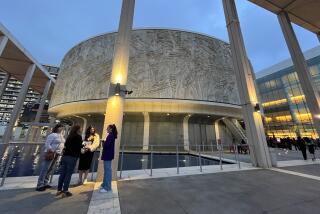Pasadena Playhouse files for Chapter 11 bankruptcy
Owing $2.3 million but holding just $102,000 in savings and cash, the Pasadena Playhouse filed for Chapter 11 bankruptcy Monday night in hopes of regaining its financial footing and eventually resuming performances on a stage that has been dark since Feb. 7.
Stephen Eich, the nonprofit theater company’s executive director, had no comment Tuesday about what might happen next but said playhouse leaders hope to provide more details in the coming days about their strategy for recovering sufficiently for shows to resume.
“It has taken longer than we thought” to decide on the bankruptcy filing and prepare the necessary information, Eich said. “We think we’ve done it correctly, and we’re in good hands with Munger, Tolles & Olson,” the Los Angeles law firm that is representing the playhouse in U.S. Bankruptcy Court.
A list of creditors was not available, but the filing said they numbered 1,000 to 5,000; the majority are subscribers who paid in advance for plays that haven’t been produced. In March, KOST-FM sued the playhouse in Los Angeles Superior Court, claiming it was owed $31,300 plus interest and attorney fees for a 2009 contract to air 30-second commercials for productions and do on-air ticket giveaways.
The playhouse, which averaged $8.1 million in expenditures during 2007 and 2008, according to financial information that accompanied its bankruptcy filing, became the second major Southern California arts organization to go bankrupt amid the current economic downturn.
Opera Pacific closed in November 2008, ending its 22-year run at the Orange County Performing Arts Center in Costa Mesa. Unlike the playhouse’s Chapter 11 filing — a path designed to allow debtors to get back on their feet — the opera company filed under Chapter 7, a final settling of affairs. The opera company wound up selling its Santa Ana headquarters for $1.5 million to pay off most of its $1.7 million debt.
Although the playhouse claims $7 million in assets, the vast majority of those — $5.9 million — are pledged donations, not cash or investments. The pledges are not for general expenditures but were given to a campaign that began in 2007 to add a 300- to 400-seat theater to the 684-seat main stage and 86-seat Carrie Hamilton Theatre.
As assets, the playhouse lists $385,000 in accounts receivable, $145,000 in items such as prepaid insurance and just more than $1 million in fixed assets — theater equipment, office equipment and improvements to its two leased stages.
Its liabilities include $422,000 in accounts payable, $1.1 million received from subscribers to its six-show 2010 season, only one of which was performed before the shutdown, and two bank loans totaling $572,000. Also listed is a $49,000 loan from the city of Pasadena.
The financial information for its 2008 operations showed that the playhouse earned $3.1 million from ticket sales and received $1.4 million in “production enhancement,” the money outside commercial producers pay to nonprofit theaters to help them mount plays that the outside producers hope to send to Broadway. Not counting a $3-million gift toward its expansion campaign, the playhouse raised $1.5 million in donations. Leaving aside paper expenses — depreciation and an unspecified $566,000 writedown for “abandonment of an asset” — the playhouse’s operating expenses during 2008 came to about $7.4 million and exceeded revenues by about $1.3 million.
Two salaried employees earned six figures during 2008: Production director Thomas Ware received $135,000 and then-managing director Brian Colburn, $108,000. Sheldon Epps, the longtime artistic director, was paid as an independent contractor, earning $205,000.
An estimated five-month budget the playhouse filed Monday shows $320,000 in projected expenses through September, mainly salary and benefits for “core administrative staff,” and $299,000 in income, most of which is expected to come from donations.
More to Read
The biggest entertainment stories
Get our big stories about Hollywood, film, television, music, arts, culture and more right in your inbox as soon as they publish.
You may occasionally receive promotional content from the Los Angeles Times.







